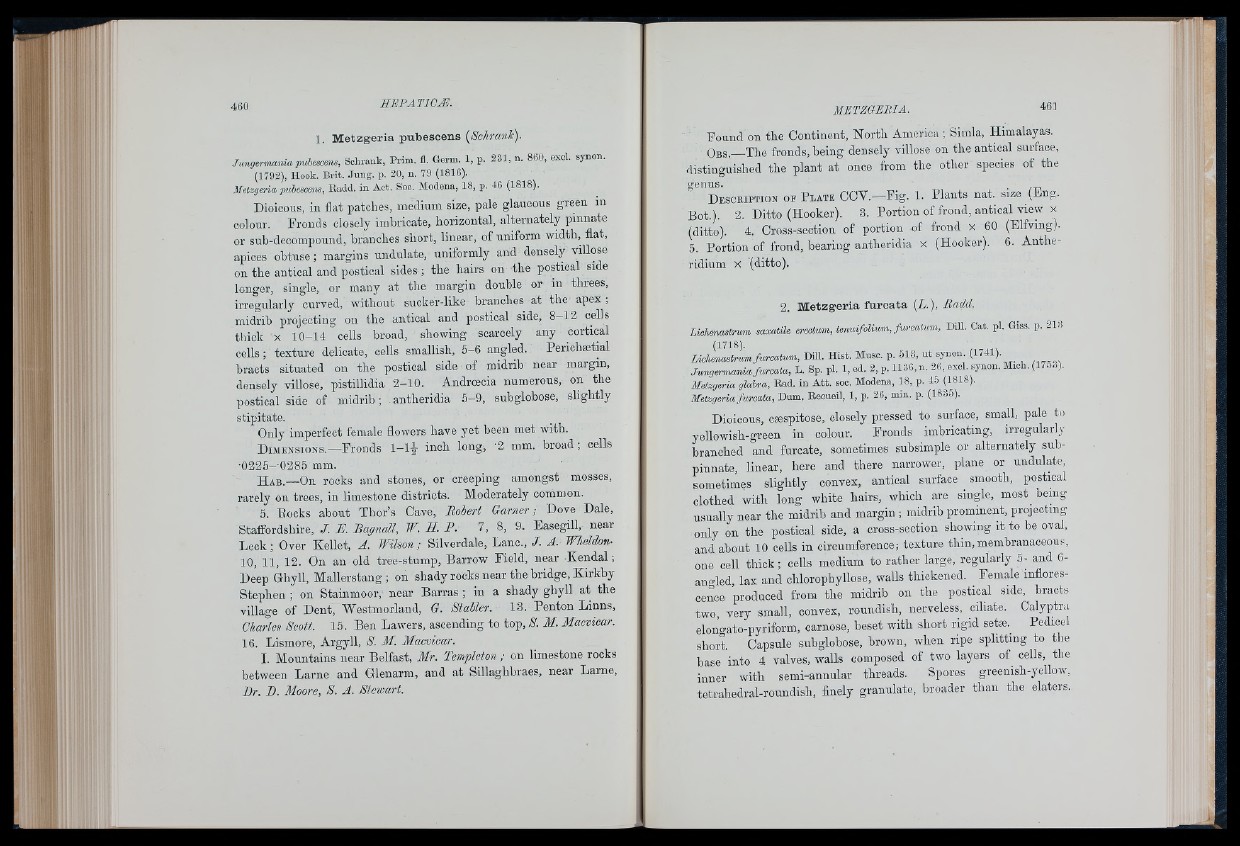
1. Metzgeria pubescens (Schrank).
Schraiik, Prim. fl. Germ. 1, p. 281, b . 8G0, excl, synon.
(1792), Ilook. Brit. Ju n g . p. 20, n. 79 (1816).
Metzgeria qnibescens, Kadd. in Act. Soc. Modena, 18, p. 16 (1818).
Dioicous, in flat patches, medium size, pale glaucous green in
colour. Fronds closely imbrioate, horizontal, alternately pinnate
or sub-decompound, branches short, linear, of uniform width, flat,
apices obtuse ; margins undulate, uniformly and densely villose
on the antical and postical sides ; the hairs on the postical side
longer, single, or many at the margin double or in threes,
irregularly curved, without sucker-like branches at the apex ;
midrib projecting on the antical and postical side, 8-12 cells
thick X 10-14 cells broad, showing scarcely any cortical
cells; texture delicate, cells smallish, 5-6 angled. Perichætial
bracts situated on the postical side of midrib near margin,
densely villose, pistillidia 2-10. Androecia numerous, on the
postical side of midrib ; antheridia 5-9, subglobose, slightly
stipitate.
Only imperfect female flowers have yet been met with.
D i m e n s i o n s . — Pronds 1 - l J inch long, '2 mm. broad; cells
■0225--0285 mm.
H ab.— On rocks and stones, or creeping amongst mosses,
rarely on trees, in limestone districts. Moderately common.
5. Eocks about Thor’s Cave, Robert Garner; Dove Dale,
Staffordshire, J. K Bagnall, W. H. P. 7, 8, 9. Easegill, near
Leek; Over Kellet, A. Wilson; Silverdale, Lane.. / . A. Wheldon-
10, 11, 12. On an old tree-stump, Barrow Field, near Kendal;
Deep Ghyll, Mallerstang ; on s h a d y rocks near the bridge, Kirkby
Stephen ; on Stainmoor, near Barras ; in a shady ghyll at the
village of Dent, Westmorland, G. Stabler. 18. Penton Linns,
Charles Scott. 15. Ben Lawers, ascending to top, S. M. Macvicar.
16. Lismore, Argyll, S. M. Macvicar.
I. Mountains near Belfast, Mr. Templeton ; on limestone rocks
between Larne and Glenarm, and at Sillaghbraes, near Larne,
Br. B. Moore, S. A. Stewart.
Pound on the Continent, North America ; Simla, Himalayas.
O b s . The fronds, being densely villose on the antical surface,
distinguished the plant at once from the other species of the
t,^enus.
D escription oe P late CCV.—Fig. 1. Plants nat. size (Eng.
Bot.). 2. Ditto (Hooker). 3. Portion of frond, antioal view x
(ditto). 4. Cross-seotion of portion of frond x 60 (Elfving).
5. Portion of frond, bearing antheridia x (Hooker). 6. Antheridium
x (ditto).
2. Metzgeria fure ata (L.), Radd.
Liehenastrum saxatile erectwm, tenuifolium, fu r ca tum , Bill. Cat. pi. Giss. p. 21.i
L ic lT lT u m fu r c a tu m , Dill. H is t. Muso. p. 513, u t synon. (U U )-
ania fureata, L. Sp. pi. 1, ed. 2, p. 1136, n. 26, excl. synon. Mich. (17o3).
i glabra. Rad. in A tt. soc. Modena, 18, p. 45 (1818).
, Dum. Recueil, 1, p. 26, min. p. (1835).
Dioicous, cæspitose, closely pressed to surface, small, pale to
yellowish-green in colour. Fronds imbricating, irregularly
branched and furcate, sometimes subsiniple or alternately subpinnate,
linear, here and there narrower, plane or undulate,
sometimes slightly convex, antioal surface smooth, postical
clothed with long white hairs, which are single, most being
usually near the midrib and margin ; midrib prominent, projecting
only on the postical side, a oross-seotion showing it to be oval,
and about 10 cells in circumference; texture thin, membranaceous,
one cell thick; cells medium to rather large, regularly 5- and 6-
angled, lax and chlorophyllose, walls thickened. Female inflorescence
produced from the midrib on the postical side, bracts
two, very small, convex, roundish, nerveless, ciliate. Calyptra
elongato-pyriform, carnose, beset with short rigid setæ.^ Pedicel
short Capsule subglobose, brown, when ripe splitting to the
base into 4 valves, walls composed of two layers of cells, the
inner with semi-annular threads. Spores greenish-yellow,
tetrahedral-roundish, finely granulate, broader than the elaters.